72-year-old male patient with two previous myocardial infarctions and bypass surgery underwent EECP Heart therapy


Markedly improved anterior, septal, and inferior wall perfusion
| Evaluation | Outcome |
|---|---|
| Ischemic cardiomyopathyProgressive angina with minimal exertion100 percent occlusion of proximal portions of all three native coronary arteriesMaintained on medical therapy | Following 35 sessions (lasting one hour each) of EECP® treatmentLeft ventricular ejection fraction (LVEF) increased by 80 percent from baselineFunctional status and chest pain improved markedlyPost-treatment stress test showed improved cardiac perfusion and function |
27-year-old male patient with family history of hyperlipidemia underwent EECP Heart therapy


Markedly improved anteroseptal and inferior wall perfusion in post-EECP® treatment stress scintigram
| Evaluation | Outcome |
|---|---|
| Exertional angina1.5-2.0 mm horizontal ST segment depression on exercise treadmill test100 percent occlusion of mid-right coronary artery100 percent occlusion of mid-left anterior descending coronary artery95 percent blockages in both proximal mid-right coronary artery and small branch of left circumflex coronary arteryConsidered not suitable for interventional therapy | Following 35 sessions (lasting one hour each) of EECP®® treatment Angina was completely eliminated at normal levels of exertion Post-treatment radionuclide stress testing showed marked improvement in myocardial perfusion |
72-year-old male patient with history of diabetes, gout, hypertension, triple-vessel coronary artery disease (CAD)


Markedly improved anteroseptal and inferior wall perfusion in post-EECP®treatment using stress scintogram
| Evaluation | Outcome |
|---|---|
| Stable anginaPreviously declined bypass, maintained on medicationStress test suggested progression of CADSevere hypo perfusion of inferior wall and apex with stress perfusion | Following 35 sessions (lasting one hour each) of EECP® treatment Post-treatment stress testing revealed marked improvement in myocardial perfusion Increased exercise ability Chest pain symptoms were eliminated Patient no longer required nitroglycerin |
Enhanced External Counterpulsation (EECP®): Congestive Heart Failure update
Prepared by Dr. Ramasamy
The value of EECP® in Chronic ischemia and improvment of heart disease symptoms are well established. We know from the Anginal studies With EECP®, coronary blood flow is increased during diastolic phase (1,2), cardiac output is increased (3), cardiac after load is decreased, collateral vessels are recruited and enlarged, nitric oxide, antioxidant (4), VEGF, ANP (5) levels rise. Renin (6) endothelin (7) and BNP levels fall (8), PET (9), Thallium (10,11), Exercise tolerance, Exercise induced myocardial ischemia improves (12) and frequency of angina decreases, use of nitro decreases and patient sense of well-being and quality of life improves (13). Also the beneficial effects of EECP® attained during the treatment have been shown to last for three to five years (14, 15).
FDA granted 510(k) clearance to Heal your heart EECP®-MC2 treatment for CHF on July 2002.
The prevalence of congestive heart Failure is growing rapidly as a result of the aging of the population and the improved survival rate of people after heart attacks. Symptoms of heart attack includes shortness of breath, easy fatigability and poor exercise tolerance. Also, because the condition frequently entails visits to the emergency room and in-patient treatment, two-thirds of all hospitalizations for people over age 65 are due to CHF. It is now certain the prevalence of heart failure will continue to grow both in developed and developing nations. EECP treatment will improve heart disease symptoms
EECP® is the only medical device can be used with all classes of CHF patients.
Efficacy and safety of EECP® in Mild to moderate heart failure. Preliminary report.
(Journal of cardiac failure 2000 6(3): 48(180) Total 6 patients ---- 5 Ischemic Cardiomyopathy and 1 dilated Cardiomyopathy.
All patients clinically stable with LVEF < 35%. NYHA class II AND class III.
V02 Max (ml/kg/min) ---------------------Increase 18.7 %
Exercise duration -------------------------Increase 33.9%
Quality of life------------------------------Improved 35.3%
| Parameter | Pre-EECP® | During EECP® | % Change |
|---|---|---|---|
| Functional Class | 2.0 | 1.2 | 5/6 improved |
| V02max(ml/kg/min) | 13.6 | 15.9 | by 18.7% |
| Exercise Duration | 592 sec. | 756 sec. | by 33.9% |
| Minnesota Score | 36 | 22 | by 35.3% |
Conclusion:
EECP® is Efficacious and well tolerated by Heart failure patients in short term. Enhance External Counterpulsation in Heart Failure patients. A Multicenter feasibility study (CHF. 2002; 204-208,227) Total 32 patients. 1 week and 6 month follow up.
All patients are clinically stable with LVEF< 23.2%±7.4
Adverse event leading to discontinuation of treatment
1 patient due to severe back pain EECP® related
3 patients due to Arrhythmia and worsening of CHF not related to EECP®.
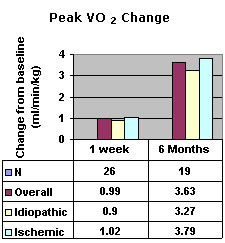
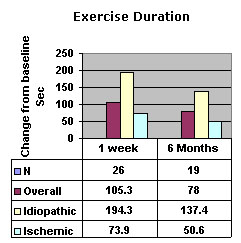
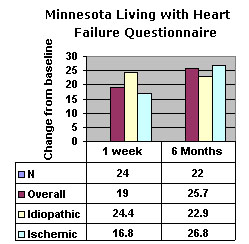
At 6 months when compare to the baseline mean Exercise time increased by 15.5% and peak oxygen uptake increased by 27.09%.
Conclusion:
The benefit consists of significant increase in exercise capacity (peak oxygen uptake and exercise duration) and the benefits were persisting when followed up to 6 months. The benefits were similar in both Ischemic and idiopathic Cardiomyopathy. Improvement in Left Ventricular performance by Enhance External Counterpulsation in patients with Heart Failure. Journal of American College of Cardiology. 2000; 35(2): 230A#901-5 No of patients 8 with NYHA Class II OR III with LVEF < 35%
Conclusion:
EECP® may be beneficial to LV function in Heart failure patients improvement in preload-adjusted maximal power (PAMP) indicate improvement in myocardial contractility independent of pre-load and has the potential as an adjunctive to medical therapy in these patients. Does EECP® improve Cardiac Function in Ischemic Cardiomyopathy? Presented at the American Federation for Medical Research, Baltimore Maryland April 12 2002. Total patients 24.
| Parameter | 19 patients (LVEF>35%) | 5 Patients (LVEF< 35%) |
|---|---|---|
| Stroke Volume (cc) | 0% | 12% |
| Systemic Vascular Resistance | + 4% | - 11% |
| Cardiac output (L/min) | - 4% | 18% |
| Cardiac index (L/min/m2) | - 4% | 15% |
Conclusion:
EECP® improves cardiovascular indices in patients with severe left ventricular dysfunction. The improvement in cardiovascular indices in more pronounced in patients with severe left Ventricular dysfunction with EF < 35%.
Enhance External Counterpulsation Improves Exercise Tolerance, Reduces Exercise Induced Myocardial Ischemia and Improves Left Ventricular Diastolic Filling in patients with coronary artery disease J Am Coll Cardiol 2001: 37: 93-9
This paper indicates the mechanism of EECP®. It looks at the effect of EECP® on diastolic dysfunction. EECP® shown to decrease left ventricular end diastolic pressure (LVEDP), increase peak filling rate and decrease time to peak filling rate. Also decrease the plasma level of Brain Natriuretic peptide.
In ventricular diastolic dysfunction, ventricular end diastolic pressure increases reflecting its stiffness against filling during the diastole phase of the heart. This impaired filling due to problem in relaxing of ventricle leads to accumulation of fluid in the feet, ankles and legs. EECP® has been clearly shown to improve left ventricular diastolic filling, which may result in improvement of edema and clinical symptoms.
Plasma brain Natriuretic peptide rises in symptomatic heart failure and Abnormal LVEF. BNP is mainly secreted from left ventricular wall when subjected to stress or stretch. BNP level greater than >100pg/mL indicates heart failure. Plasma level BNP significantly reduced after EECP®. BNP negatively correlate with ventricular filling pressure. Improved diastolic filling associated with decrease BNP.
Effects of EECP® on Left Ventricular Diastolic Filling
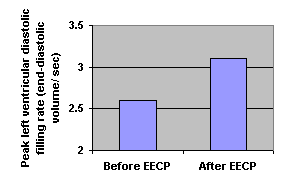
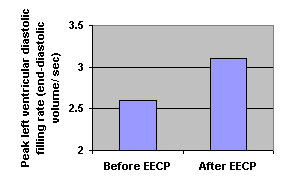
Enhance External Counterpulsation improved myocardial perfusion and coronary flow reserve in patients with chronic stable angina
European Heart Journal (2001) 22, 1451-1458
This paper gives another insight in to the mechanism of EECP® in congestive heart failure by measuring Nitric oxide, Brain Natriuretic peptide and atrial Natriuretic peptide.
From previous study we know EECP® decreases the plasma level of BNP but we have no clue about how long the effect will last. This study measures the decrease level of BNP and ANP was maintained for I month after completion of EECP® treatment. The raised level of nitric oxide also was maintained for 1 month. This increase nitric oxide suggests a profound improvement in endothelial function. The increase nitric oxide would not only be confined to coronary arteries but also to systemic arteries. This result suggests the decrease in after load during EECP®. This gives the insight the benefit of EECP® is not only due to improvement in myocardial perfusion but also due to decrease in cardiac workload and improvement in endothelial dysfunction.
Effects of EECP® on Left Ventricular Diastolic Filling
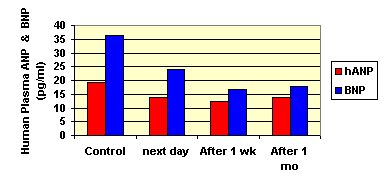
Nitric Oxide and EECP® Therapy
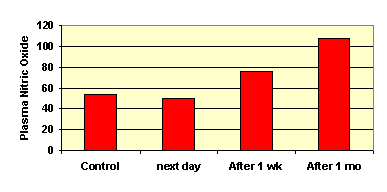
A Neurohormonal Mechanism for the effectiveness of Enhance External Counterpulsation.
(Circulation 1999; 100(8))
EECP® cause a sheer stress in Vascular Endothelium, which stimulates the release of Neurohormonal factor. The endothelial dependent Vasoreactivity is a balance between endothelial derived relaxing factors and endothelial derived contracting factors. Any deviation from this balance mostly impairment of Vasorelaxation is defined as Endothelial Dysfunction. One of the non-pharmacological stimuli that cause vasorelaxation is Shear stress.
To study the effect o sheer stress in vascular endothelium causes by EECP® the investigator Gu-fu Wu measures the two Neurohormonal factors nitric oxide and endothelin.
Effects of EECP® Treatment Changes in Plasma

Effects of EECP® Treatment Changes in Plasma Nitric Oxide
Endothelin and nitric oxide were measures pre-EECP®1 hr, 12th hr, 26th hr, 36th hr and 1st and 3rd month of EECP® treatment. The nitric oxide significantly increased and endothelin level significantly decreased proposition to the duration of treatment. The change in ratio was significant even after 1 month after the treatment. By 3rd month the ration tends to move towards the baseline.Intermittent shear stimuli by Enhance External Counterpulsation (EECP®) restores Endothelial Function in patients with coronary artery diseases(Circulation 102:18 Suppl. II Oct 00')
Endothelial health is a key indicator of cardiovascular health and long time outcome of the patients. Endothelial dysfunction is the imbalance between the vasodilatation and vasoconstriction factors secreted by Endothelium. We already know EECP® improves the vasodilatation by increasing the nitric oxide level and decreases the vasoconstriction by decreasing the endothelin level. This study shows EECP® improves the Ischemic symptoms and long time outcome by restoring endothelial function. Endothelial function can be accurately assessed by brachial flow arm mediated vasodilatation technique.
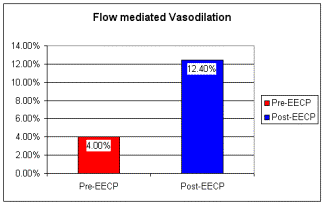
Flow mediated Brachial Vasodilatation was significantly impaired at the baseline at 4% and increases up to 3 fold after 35 hrs of EECP® restoring almost towards the normal value.
Improvement of renal perfusion and function by pneumatic external Counterpulsation.
D. Werner et al 20th Congress of the European Society of Cardiology Abstract P3660 September '98 Vienna, Austria.
The increase in retrograde blood flow during diastolic period not only increases coronary circulation but also improves blood flow in other organs including kidney. Parameters of kidney functions where measured in 12 healthy individuals. External Counterpulsation increases renal perfusion, urinary production, sodium and chloride excretion and decreases plasma endothelin and renin production. These findings were summarized in the tabular column below.
| Parameter | Pre-EECP® | 5 Patients (LVEF< 35%) | % Change |
|---|---|---|---|
| Stroke Volume (cc) | 522 ml/min | 676 ml/min | + by 21% |
| Systemic Vascular Resistance | 0.18 mmol/min | 0.35 mmol/min | + by 94% |
| Cardiac output (L/min) | 0.1 mmol/min | 0.22 mmol/min | + by 120% |
| Cardiac index (L/min/m2) | 3.3 ml/min | 3.2 pg/ml | - by 37% |
| Cardiac index (L/min/m2) | 4.4 pg/ml | 14.3% | 15.6% |
| Cardiac index (L/min/m2) | 9.5 pg/ml | 7.5 pg/ml | - by 27% |
The Neurohormonal change in heart failure occurs due to decrease in cardiac out put and increase in wall stress. The notable changes take place in adrenergic system, reninangiotensin-aldosterone system (RAAS), hypothalamic-neurohypophyseal system and endothelin. All this system activation helps to increase blood volume, enhance contraction of ventricles, and maintain mean arterial pressure to preserve the vital perfusion pressure in coronary, cerebral and other organs. This system activation provides short time Hemodynamic support but in long time it is deleterious associated with Myocardial fibrosis, adverse ventricular remolding and endothelial dysfunction.
Beneficial effect of EECP®on the Renin-Angiotensin in patients with coronary artery disease
(European society of cardiology sep-1-5 2001) Stockholm Sweden.
We now know from our previous study, EECP® increases renal perfusion and causes sheer stress in vascular endothelium, which in turns mediate, the release of nitric oxide and decrease the endothelin concentration in the plasma.
is study shows the beneficial effect of the increase renal perfusion in Renin-Angiotensin-Aldostrerone system (RAAS). There is decrease in Angiotensin converting enzymes and Angiotensin II. This inhibition of RAAS system has favourable effect on decreasing the stiffness of the ventricle and improving ventricular filling, improving the homodynamic burden placed on the failing ventricles, and decreasing myocyte apoptosis. All this factors together responsible for the potential benefit of EECP® treatment.
Effects of EECP® on Plasma ANG II Activity
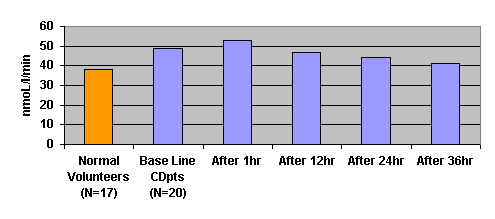
Enhance External Counterpulsation Pulsation is a safe and Effective treatment for Angina in patients with severe left ventricular dysfunction. (IEPR) (Journal of cardiac failure 1999; 5(3): 72(#268)).
Total 466 patients.
| LVD | PLVD | |
|---|---|---|
| Total (466) | 127 | 339 |
| Aggravation of CHF | 3.9% | 1.9% |
| Anginal Improvement | 3.1 to 1.7 | 2.8 to 1.4 |
| Treatment Completed | 83% | 82% |
Conclusion:
EECP® is safe and effective and the Anginal class improvement is independent of the degree of left ventricular dysfunction.
Six Months outcome of patients with Left Ventricular Dysfunction treated with Enhance External Counterpulsation for Chronic angina. (IEPR)
Data presented in August of 2000 at the European Society of Cardiology meeting in Amsterdam. Journal of Cardiac Failure 2000; 6 (3): 75 (282).
Because of the higher mortality associated with CHF this study perform 6 month follow up on patient with LVD and chronic angina for Major averse cardiac event and mortality.
Total Patients 554 Six month follow up.
| LVD | PLVF | |
|---|---|---|
| Total (554) | 129 | 425 |
| LVEF | < 35% | > 35% |
| Death | 7.0 | 1.6 |
| MACE (Death/MI/CABG/PCI) | 10.6 | 6.6 |
| Anginal Improvement | 70% | 79% |
90% of patients with severe LVD did not suffer any major cardiac events.
Conclusion:
Patients with LVD achieved considerable reduction with EECP® and the majority of these patients this reduction was maintained at six month.
Benefit and safety of Enhance External Counterpulsation in treating Coronary artery Disease patients with a history of Congestive Heart Failure. (IEPR)
Cardiology 2001; 96; 78-84
Total 1,957 patients, 548 with history of heart failure and 1,409 without history of heart failure.
Events occurring during the 6 months following EECP® therapy by CHF status.
Major adverse cardiac events (Death/MI/CABG/PCI)
| Without H/O CHF (N= 1,157) | With H/O CHF (N= 444) | |
|---|---|---|
| MI | 2.5 | 3.6 |
| Unstable Angina | 7.4 | 9.0 |
| CHF | 2.4 | 7.2 |
| CABG | 2.0 | 1.1 |
| PTCA | 2.9 | 2.5 |
| Death | 2.2 | 7.9 |
| Cardiac hospitalization | 13.6 | 19.1 |
Given the severity of the disease suffered by this group MACE is within expectation.
In subgroup analysis patients with a history of CHF and severe left ventricular dysfunction (EF<35%) revealed that this patients benefited similarly to those patients with less severe ventricular dysfunction after EECP® treatment.
Conclusion:
EECP® is effective in improving angina in coronary patients with a history of CHF. Acute treatment did not cause major adverse cardiac events in this high-risk group of patients, although 7.3% experienced worsening of their CHF. At 6 months majority of the patients maintained their improvement.
References